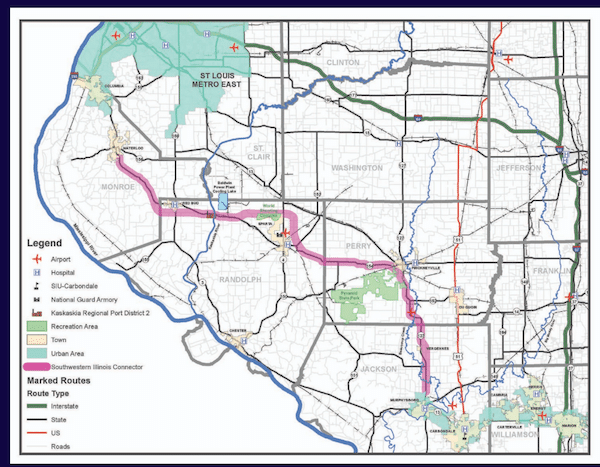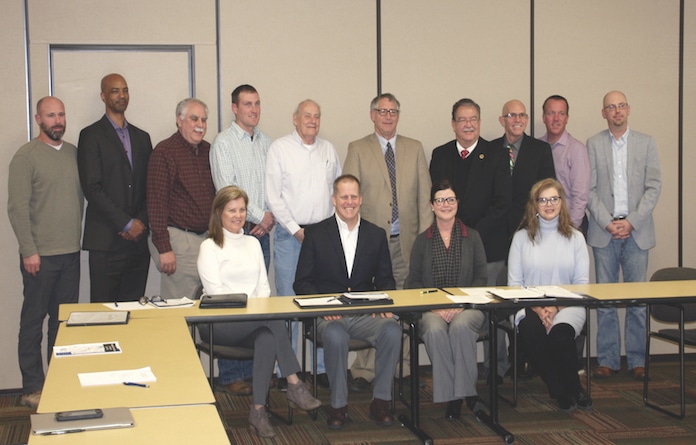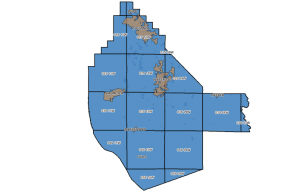Connector task force finishes report

The Southwest Illinois Connector Task Force has completed a draft of its report and will finalize that draft before the end of the year and submit it to the state.
The task force was created by the Illinois General Assembly last year to study the cost, feasibility, economic impact, funding options and environment al impact of a four-lane highway from Waterloo to Murphysboro.
The group, which includes local lawmakers, stakeholders and Illinois Department of Transportation officials, discussed the draft at its final meeting Dec. 13 before voting unanimously to approve it and the necessary changes.

State Sen. Paul Schimpf (R-Waterloo), who championed a measure creating the task force, noted the members of the group were not paid for their efforts before thanking them.
“I just want to say thank you for the work that everybody’s done,” Schimpf said. “I’ve had a chance to read your draft report, and I think the end product is very impressive.”
State Rep. Nathan Reitz (D-Steeleville), who also co-sponsored legislation to create the task force, echoed Schimpf’s sentiments.
“I jumped in late on the task force, and I’m glad to be a member of it,” he said. “Thank you everyone for your time and our commitment. I think the report looks wonderful.”
The nearly 120-page document lays out the case for expanding two-lane roads along a proposed route called the focus study area, noting how it would solve or alleviate problems in areas like safety and economic development.
Southern Illinois University Carbondale Director of Small Business Incubator Programs Deborah Barnett, Task Force Chairman Marc Kiehna, Randolph County Economic Development Coordinator Christopher Martin and IDOT District 9 Project Engineer Carrie Nelsen wrote the report.
“The proposed Southwest Illinois Connector Highway Project has the capability to solve a multitude of problems and issues for the residents of the area,” the report says. “Major problems to be solved include: traffic safety, economic development, access to health care, educational employment and opportunities, existing roadway deficiencies, national defense, multi-modal movement of goods, regional connectivity, school bus safety, community development and home building and access to recreational opportunities and tourism.”
Much of the document consists of text and images explaining how the proposed highway would make traveling in this area safer and easier.
According to the report, the focused study area includes five sections IDOT recognizes as being in the top 5 percent of two-lane highways in Illinois for the number of fatal and serious injury crashes.
Since 2012, there have been 1,617 crashes in the focus study area that have resulted in 22 fatalities and 210 motorists sustaining severe injuries.
The project would expand the shoulders, provide a grass median, add turn lanes, grade roadway ditches and remove objects drivers could run into, all of which Nelson said should help reduce crashes.
On the economic development front, the report notes there are several large employers, vital tourist attractions, existing transportation hubs like the Kaskaskia Regional Port District, hospitals and SIUC in the area of the proposed highway, all of which would benefit from the highway.
Additionally, the report says the highway could bring more jobs to the area.
“Most potential new or relocating national or international manufacturing projects require proximate four-lane access as a requisite,” it says. “The lack of four-lane access automatically excludes communities for competing for these projects, therefore creating a regional disadvantage as it relates to economic development.”
Despite these benefits, the task force acknowledges in the report this is a challenging project, a version of which was considered as early as 1967.
Perhaps the chief barrier to expanding the approximately 72 miles of roads is the price tag, as the report estimates the entire project would cost about $805 million.
The work would be done in sections, with the most expensive predicted to be the one from Route 3 in Waterloo just south of Market Street to Route 4 near the World Recreational Shooting Complex in Sparta.
That roughly 29-mile section would cost an estimated $360 million for environmental studies, public involvement, engineering, land construction, utility relocation and construction.
Kiehna said the cost would be worth it, as evidenced by the municipalities and businesses that have written letters of support for the highway including Waterloo, Monroe County, IMO’s Franchising in Waterloo and Red Bud Regional Hospital.
Although the task force disbanded after the meeting and will soon submit its report, there is still much work to be done before the project happens.
That includes getting help from IDOT to get funding from the state and federal government to pay for the work, which involves getting support from legislators and the public.
“This is just the beginning of this, and as we look at getting serious about where a road will end up, there will be hearings, there will be… fundamentals that have to happen,” Kiehna said.
The final version of the report will be available on the task force’s website, which is siconnector.com.






